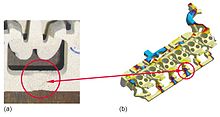Core shooting simulation
The core shooting simulation ( core simulation) is used in casting technology to optimize the production of sand cores. Sand cores are used in casting molds to manufacture cast parts with cavities or geometric structures. The recesses created during casting through the cores serve to save weight or realize functional properties.
Sand cores are mainly produced using a machine process, core shooting. A mixture of sand and binding agents is “shot” into the core mold (or core box) with a defined pressure. The process of core shooting has a significant impact on the overall manufacturing costs and the resulting quality of the casting. Defects in the core are reflected directly in casting defects and undesired casting properties. Since the geometries of cast parts are becoming more and more complex, the technical and economic requirements for core production are also increasing. In the core simulation, the core shooting process (including gassing, curing and venting) is virtually predicted by software and mapped over time using an animation. The different flows of sand and air, their interactions with each other and with the environment of the core box are dynamically modeled.
A core simulation can take into account both cold-curing processes (cold box process) and core production in hot core tools (hot box process, inorganic binders). The simulation results show how process parameters - shooting pressure, number and positions of shooting and ventilation nozzles or sand-binder mixture - have to be selected in order to obtain the required sand density everywhere and to economically manufacture cores with which cast parts can be used in produce the desired quality.
See also
literature
- M. Schneider, R. Stevenson: Simulation of the entire core production process . AFS Transactions 2012
- Wagner, M. Schneider: Core simulation - efficient process optimization in the foundry . Giesserei-Rundschau 58 (2011), issue 9/10 2011, pp. 224–228
- Wagner and M. Schneider: Core simulation . Giesserei 96 (2009), issue 12/2009, pp. 16-29


